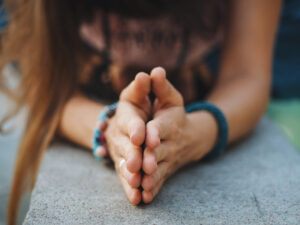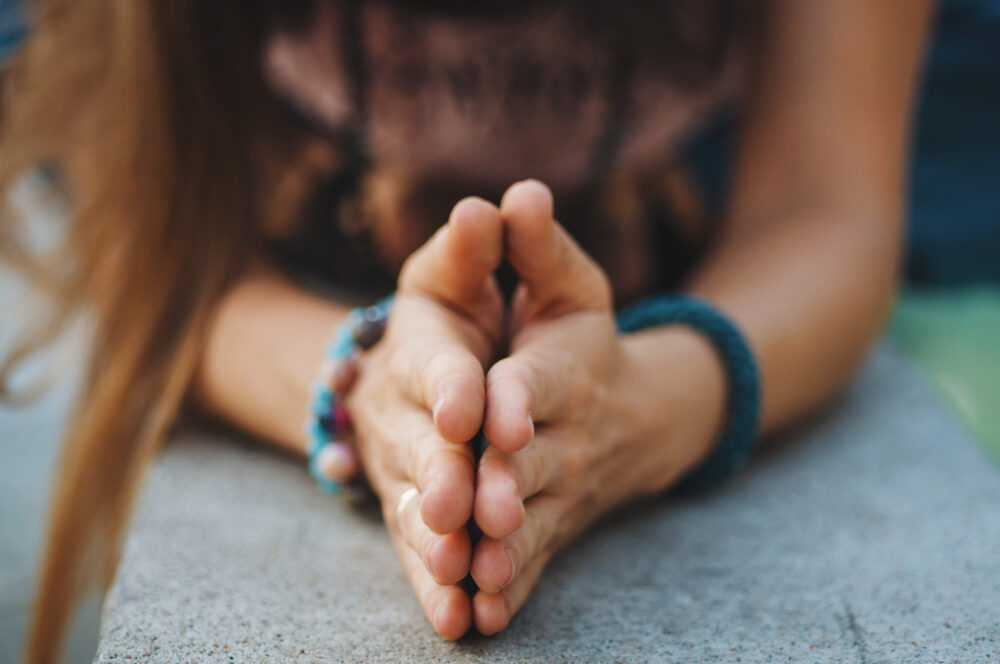Yoga is for EveryBODY!
Not too long ago in a group yoga class, the teacher made a joke about her post-lockdown pancake belly. It was a joke, yet it made me sad.
I wondered if the teacher had considered the impact of her language around body image and body comparison. While the majority of the room laughed, I also wondered who was being triggered, who was feeling alienated and what beliefs were being strengthened.
When I began practising yoga 30 years ago, I did so in pursuit of that ‘yoga body’. You know – the thin, mobile, youthful looking body. Yoga had recently gained popularity in the West and it was being endorsed by lean, flexible, white celebrities.

Fortunately, as I attended classes, I was given the space to feel, to move with sensitivity and develop a deep respect for my body, just as it is.
I recovered from my exercise addiction and started to enjoy my curves, increasingly finding delight in slower, more feminine movement patterns.
Today yoga is part of many gym schedules. Some of the newer styles also place their emphasis on physical fitness, including advanced yoga postures in general classes.
A search for #yogateacher on social media floods the screen with perfect looking people in perfect looking poses, and while these images can be aspiring and inspiring, they can also be intimidating for those who do not fit this mould.
Yoga is inherently an inclusive practice. Anyone can apply its guiding principles: sensitivity to sensations, awareness of breath, trust and self-acceptance. It is also a deep practice for healing and change.
Yet many people feel like yoga isn’t suited to their body and therefore isn’t suited to them, and others that do practice yoga feel like they don’t look good enough to teach.
But that’s simply not true. Despite what social media may show, anybody can do yoga and anyBODY can teach yoga. I have been teaching yoga for 15 years and still have my legs bent in forward folds and cannot do deep backbends – my body just doesn’t bend that way. And I’m ok with that.
Everyone’s joints, ligaments, muscles and tendons are different. Everyone’s body shape is different. For me, I have found having limitations to posture practice to be an advantage to my teaching, as I am able to teach with compassion, make students feel comfortable with their own limitations and teach them what I’ve learned in my own body.
As yoga teachers we have a responsibility to demonstrate body-acceptance and body inclusivity. We have the privilege of guiding students to move, to feel and to take up space. And while movement is easy for some, for others, simply being present and still in their body is uncomfortable.
Adopting a feminine approach to yoga teaching, which is grounded in the principle of Ahimsa, or self-compassion, can make classes more accessible for everyone.
The Bliss Baby Yoga approach teaches that bodies change throughout our lifespan. Yoga classes should also reflect this and accommodate bodily variations including pain, injury, disability, hormonal changes, pregnancy, postnatal and other health conditions.
There is no such thing as the perfect yoga teacher. If we can celebrate our own imperfections then we can encourage our students to do the same. Here’s how:
Embrace your own body, just as it is, so that your students can embrace theirs
Consider how you view your own body. Do you engage in negative self body talk? Are you critical to aspects of your physical appearance? Do you judge other people’s bodies?
Can you disregard cultural narratives that tell you your body exists simply for others to gaze at and evaluate. Can you reject harmful appearance norms and appreciate your body for what it does for you, not for how it looks?
Teach self-enquiry
Ask your students questions that encourage curiosity. This will help them to find the best way to modify the pose for their body. Ask – how does this pose feel? Where do you feel sensations?
What happens if you move your hips a little to one side or the other? What happens if you take your feet wider or narrower? What happens to the pose/and your breath if you use a block/pillow/bolster?
Questions such as these draw the student’s attention into their body in an inclusive way and invite students to pay attention to their individual experiences.
Ahimsa as the compass
Teach students to move with a sensitivity to sensation and focus on what they can feel rather than what they can do. This way it doesn’t matter how flexible they are, or what the pose looks like.
Use asana practice to invite play and exploration. Pleasure leads to embodiment, so if we guide students to follow sensations of delight, move in ways that feel good, find comfort in a pose, and to rest when necessary, it can encourage body positivity.
Be real on social media
Show up on social media as you are, without filters and post the photo even if it’s not considered ‘perfect’. Use the platform to create a new paradigm around body image.
Tammy Shemesh is a Prenatal, Postnatal and Women’s Yoga teacher, Clinical Nutritionist and Eating Psychology Coach specialising in body image. Tammy is also a Bliss Baby Yoga graduate and has supported us with marketing. She now runs a nutrition clinic with a special interest in pre and postnatal nutrition.
If you are passionate about nurturing women, you may be interested in our Bliss Baby Yoga Online Yoga Teacher Training courses. We offer specialist training in Prenatal, Postnatal, Restorative and Yoga for Fertility. We also offer Online Extension Modules to enhance and further your learning covering topics including Perinatal Nutrition & Ayurveda, Prenatal & Postnatal Anatomy and Physiology and Pelvic Floor Anatomy and Physiology for Women’s Health.
Further Reading related to this topic:


Comments are closed.